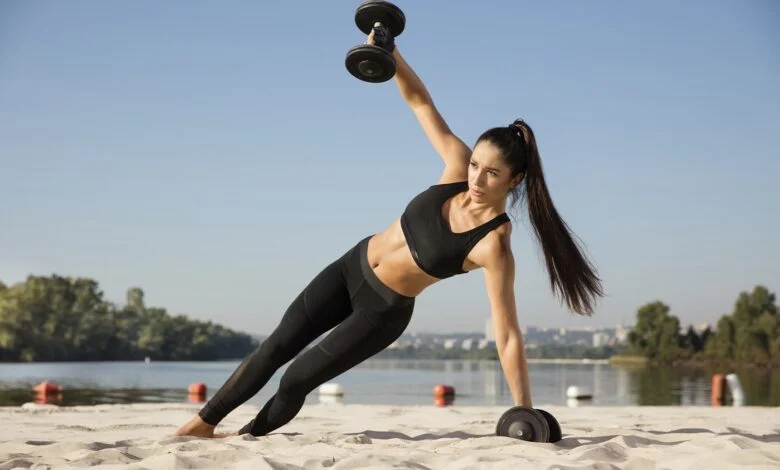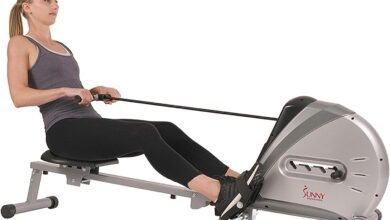The Greatest Revolution in Working out Exercise with High Intensity Intervals (HIIT)

Exercise practices are being revolutionized by High-Intensity Interval Training (HIIT) which has become a game-changer in the fitness sector. With its blend of intense bursts of exercise and short recovery periods HIIT has captivated fitness enthusiasts worldwide. Let’s delve into this revolutionary workout regimen and uncover its benefits techniques and the science behind its effectiveness.
Understanding HIIT
HIIT is a workout methodology characterized by alternating short intense bursts of exercise followed by brief recovery periods or low-intensity activities. This cycle is repeated typically in a short timeframe creating an intense workout session. The exercises involved in HIIT can range from cardio workouts like sprinting cycling or jumping jacks to strength exercises such as bodyweight squats push-ups or kettlebell swings.
The Science behind HIIT
The way HIIT affects the cardiovascular and metabolic systems of the body determines how effective it is. According to research HIIT may greatly increase cardiovascular fitness. Enhance insulin sensitivity and burn calories during and after exercise making it an effective weight loss and general health enhancement tool.
Benefits of HIIT
- Efficiency: HIIT sessions are short yet effective making them ideal for individuals with busy schedules. A 20-30-minute HIIT workout can yield comparable or even superior results to longer moderate-intensity workouts.
- Fat Loss: HIIT’s ability to elevate the body’s metabolic rate post-exercise leads to increased fat burning aiding in weight loss and body composition improvement.
- Cardiovascular Health: Regular participation in HIIT has been shown to enhance cardiovascular health improving heart function and endurance.
- Muscle Tone and Strength: HIIT incorporates strength exercises contributing to muscle building and toning enhancing overall strength and endurance.
Executing HIIT Workouts
- Warm-up: Begin with a 5-10 minute warm-up to prepare the body for intense activity. Dynamic stretches or light cardio are excellent choices.
- Interval Structure: Alternate between high-intensity exercise and periods of low-intensity activity or rest. For instance, sprint for 30 seconds followed by 30 seconds of walking or slow jogging.
- Workout Duration: HIIT workouts typically range from 15 to 30 minutes including both high-intensity and recovery intervals.
- Cool-down: Conclude the session with a 5-10 minute cool-down incorporating static stretches to aid in muscle recovery and flexibility.
Safety Considerations
While HIIT offers numerous benefits it’s crucial to approach it with caution especially for beginners or individuals with certain health conditions. Gradually build intensity listen to your body and ensure proper form to prevent injuries.
HIIT work
High-intensity interval Training (HIIT) revolves around a structured rhythm of intense physical exertion interwoven with intervals of rest or less intense activity. This technique prompts the body into brief intense bursts of exercise aiming to elevate the heart rate substantially. These high-intensity intervals are followed by short periods of active recovery or lower-intensity exercises.The core principle of HIIT lies in its cyclical nature participants engage in intense all-out effort during specific exercises or movements for a set duration followed by a brief recovery period. This cycle of high-intensity activity and recovery is repeated throughout the workout session.
During the high-intensity phases individuals typically push themselves close to their maximum capacity engaging in activities that challenge their cardiovascular system strength and endurance. This could involve activities such as sprinting jumping or rapid bodyweight exercises like burpees

or mountain climbers. These activities are designed to elevate the heart rate quickly and significantly maximizing calorie expenditure in a shorter duration than traditional workouts.
HIIT suitable for beginners
For beginners High-Intensity Interval Training (HIIT) can be tailored to suit their fitness levels and capabilities. This adaptation involves starting with shorter bursts of high-intensity exercise and longer periods of rest or lower-intensity activity. The key for beginners is to approach HIIT gradually and attentively. Begin with shorter intervals of intense exercise that challenge your body but are manageable. These intervals could consist of exercises like quick bursts of jogging in place modified jumping jacks or simple bodyweight movements performed at a higher pace.
Following each high-intensity interval allow yourself longer rest periods or perform less intense activities to recover. This recovery phase is crucial for beginners to catch their breath lower their heart rate and prevent excessive fatigue or overexertion. Listening to your body is paramount when starting HIIT as a beginner. It’s critical to monitor how your body reacts to the workouts the level of intensity and the length of the high-intensity and recovery phases. You may then start to decrease the rest intervals and raise the length and intensity of the high-intensity intervals as your strength and endurance steadily get better.
A HIIT workout last
High-intensity interval Training (HIIT) workouts are known for their flexibility in duration often spanning from 15 to 30 minutes. The hallmark of HIIT is its emphasis on intensity rather than the length of the workout session allowing for a highly effective fitness regimen within a condensed timeframe. The structure of a HIIT session typically involves brief yet intense intervals of exercise interspersed with short periods of rest or lower-intensity activity. These intervals can vary in length depending on individual fitness levels goals and the specific workout routine being followed.
During the high-intensity intervals, individuals push themselves to exert at or near-maximum capacity engaging in activities that significantly elevate heart rate and exertion levels. These intervals may include exercises like sprinting, jumping or performing rapid bodyweight movements such as burpees or high knees. The key to the effectiveness of HIIT lies in the brief yet intense bursts of activity which challenge the body and maximize calorie burn in a shorter timeframe. The subsequent periods of rest or lower-intensity activity allow for partial recovery enabling individuals to sustain the intensity during subsequent high-intensity intervals.
Exercises included in a HIIT routine
A workout regimen that accommodates varying fitness levels and personal preferences might benefit from using a variety of activities from High-intensity interval training (HIIT). The fundamental components of an HIIT session consist of these activities, which are meant to switch between high-intensity bursts and rest or lower-intensity activity intervals.
Some common exercises used in HIIT workouts include:
- Sprinting: Short bursts of running at maximum speed either in place or over a short distance.
- Jumping Jacks: A full-body exercise that involves jumping while spreading the legs and bringing the arms above the head then returning to the starting position by jumping and bringing the arms and legs together.
- Burpees: A full-body exercise that combines a squat, plank, push-up and jump providing a comprehensive workout in a single movement.
- High Knees: Running in place while lifting the knees as high as possible with each step.
- Mountain Climbers: Alternating leg movements resembling climbing a mountain, performed from a plank position to engage the core and lower body.
These exercises serve as the foundation for a HIIT workout but the beauty of HIIT lies in its flexibility. Individuals can customize their routines by incorporating various exercises that suit their fitness levels preferences and goals. Modifications can be made by adjusting the intensity duration or complexity of each exercise to accommodate different fitness levels and abilities.
HIIT suitable for everyone
High-Intensity Interval Training (HIIT) is a versatile workout method that can be adapted to accommodate various fitness levels and goals. However while it’s generally suitable for many individuals there are considerations for those with specific health conditions or injuries.
Before embarking on any new workout regimen especially HIIT it’s crucial for individuals particularly those with pre-existing health concerns to seek guidance from a healthcare professional or a qualified fitness expert. This precaution is especially important if someone has:
- Cardiovascular Issues: Individuals with heart conditions, high blood pressure or a history of heart-related problems should approach HIIT cautiously. The intense nature of HIIT may place added strain on the cardiovascular system.
- Joint Problems or Injuries: HIIT often involves high-impact movements that could exacerbate joint issues or injuries. It’s essential to modify exercises or choose low-impact alternatives to avoid worsening these conditions.
- Chronic Health Conditions: Those with chronic conditions such as diabetes, asthma or obesity should consult a healthcare provider before starting HIIT to ensure that the workout regimen aligns with their health goals and doesn’t pose any risks.
HIIT be combined with other forms of exercise
High-Intensity Interval Training (HIIT) can be a fantastic addition to a diverse fitness regimen. It complements and synergizes well with various other forms of exercise contributing to a holistic approach to fitness and overall well-being.
- Strength Training: HIIT and strength training work hand in hand to enhance fitness levels. While strength training focuses on building muscle mass and strength HIIT contributes by improving cardiovascular health increasing endurance and promoting calorie burning. The combination of both can optimize muscle growth, fat loss and overall functional fitness.
- Yoga: Integrating HIIT with yoga can provide a balanced fitness routine. Yoga promotes flexibility balance and mental clarity while HIIT adds an element of cardiovascular challenge and calorie burn. This combination can enhance physical strength, agility and overall mind-body wellness.
- Steady-State Cardio: Incorporating steady-state cardio exercises such as jogging, cycling, or swimming alongside HIIT can offer a comprehensive cardiovascular workout routine. While steady-state cardio primarily focuses on sustaining a moderate intensity over an extended period HIIT introduces intervals of higher intensity contributing to improved endurance increased metabolism and diversified training stimuli.
- Functional Training: HIIT’s dynamic movements mimic real-life activities making it an excellent complement to functional training. Incorporating functional movements like squats, lunges or kettlebell exercises within a HIIT framework can improve everyday mobility strength and overall functionality.
Conclusion
High-intensity interval training has completely changed the fitness scene by providing a quick and efficient way to work out. Fitness aficionados choose it because of its capacity to boost overall fitness levels support weight reduction and strengthen cardiovascular health. HIIT may revolutionize one’s exercise regimen and redefine what it means to reach maximum health and wellness when used properly and regularly.




